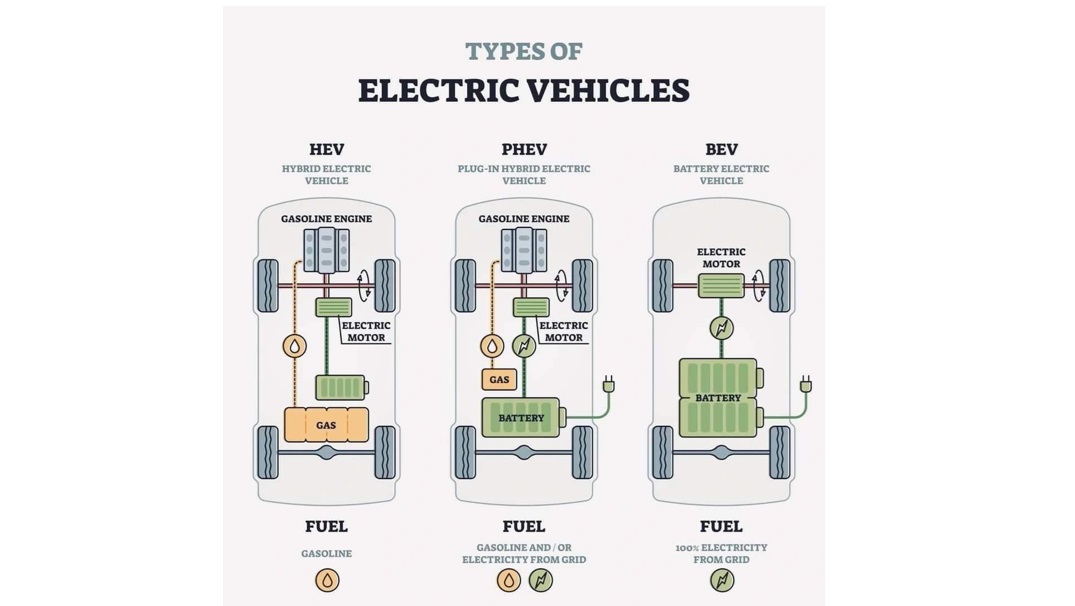Do you know your BEV from your PHEV? A beginner’s guide to Hybrid and Electric Vehicles

Do you know your PHEV from your BEV? If not, here’s a quick guide.
HEV, PHEV, and BEV are different types of electric vehicles, each with varying levels of electrification. Here’s a brief overview of each, including their technologies, advantages, and disadvantages:
1. HEV (Hybrid Electric Vehicle)
Technology: This combines a petrol or diesel internal combustion engine (ICE) with an electric motor and a small battery. This is the most common type of hybrid vehicle. It is used in some of the best known Hybrids such as the Toyota Prius or our Toyota Alphard Hybrid Eco Pioneers, and many other older Hybrids. In these vehicles, the petrol or diesel engines usually drive the wheels directly alongside or instead of the battery. In essence, these vehicles re-charge themselves and don’t plug in. They do this through regenerative breaking or a dynamo or alternator that charges the battery from the ICE when it is not needed for power (eg when accelerating or coasting along a motorway and there is excess power.

Advantages:
- Improved fuel efficiency compared to conventional cars.
- Regenerative braking helps recharge the battery.
- No range anxiety since it doesn’t rely solely on the battery.
Disadvantages:
- Limited electric-only range.
- Higher cost to buy compared to conventional cars.
2. PHEV (Plug-in Hybrid Electric Vehicle)
Technology: This also combines an ICE with a larger battery but here the battery can be charged from an external power source. This is becoming the most popular Hybrid with the Eco Revolution Ford Transit Custom PHEV one of many vehicles that have a decent sized Hybrid battery that can do over 30 miles on pure EV power and has a petrol engine that tops up the battery instead of driving the wheels. These engines are also referred to as Range Extenders. They are there to ensure the battery never runs out of power. These vehicles are essentially an EV but with the assurance of a petrol engine that prevents the battery from running out. It also uses regenerative breaking (see below for more details on how this works).

Advantages:
- Longer electric-only range, reducing the need for fuel.
- Lower emissions and better fuel economy when driving in electric mode.
- Flexibility to use both electric and combustion power.
Disadvantages:
- Higher initial cost due to the larger battery.
- Limited charging infrastructure may affect convenience.
3. BEV (Battery Electric Vehicle)
Technology: This relies solely on an electric motor powered by a large battery pack. This is used in all Tesla models and our Eco Revolution fully electric campervan.

Advantages:
- Zero tailpipe emissions, reducing environmental impact.
- Lower operating costs due to less maintenance and no need for gasoline.
- Potential for using renewable energy sources for charging.
Disadvantages:
- Limited driving range compared to traditional cars.
- Longer recharging time compared to refuelling a conventional vehicle.
- Dependence on charging infrastructure availability.
What is regenerative braking?
This is a great and simple technology that recovers energy that would otherwise be lost during braking and slowing down. When you brake in a conventional car, the kinetic energy (energy of motion) is converted into heat due to friction between the brake pads and the wheels, and this energy is lost. In contrast, regenerative braking captures some of this kinetic energy and converts it into electrical energy, which is then stored in the vehicle’s battery.
The Process
- Deceleration: When you start to slow down, the electric motor in the vehicle runs in reverse.
- Energy Conversion: This reverse operation turns the motor into a generator, converting the kinetic energy from the wheels into electrical energy.
- Energy Storage: The generated electrical energy is then stored in the vehicle’s battery for later use.
Benefits
Increased Efficiency
- By recapturing energy that would otherwise be wasted, regenerative braking improves the overall efficiency of the vehicle.
Extended Range
For electric vehicles, this means a longer driving range on a single charge.
- Reduced Wear: It also reduces wear on the traditional braking system, as the regenerative system handles much of the braking effort.
Limitations
Effectiveness at Low Speeds: Regenerative braking is less effective at very low speeds and cannot bring the vehicle to a complete stop on its own. Traditional brakes are still needed for full stopping power.
Dependence on Driving Conditions: The amount of energy recovered depends on driving conditions. Frequent stops and starts, such as in city driving, maximize the benefits of regenerative braking.
Overall, regenerative braking is a key feature in making electric and hybrid vehicles more efficient and environmentally friendly.
